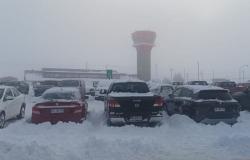Next June 24th the festival of San Juan is celebrated. Bonfires are traditional on that date, especially in the towns along the Mediterranean arc, although – with less fervor – they are also reproduced in some parts of the Rioja community. But apart from the … fiery celebration, one of the oldest and best-known streets of Logroño honors its patron these days. San Juan Street, while the rest of the city recovers from the Bernabean excesses, will experience a special bustle and joy these days.
The bars have been occupying the ground floors that were once occupied by other types of businesses, although there is still some testimonial presence of the street that was.
Along with traditional proposals, the street now also offers miniature haute cuisine dishes
But today, San Juan constitutes one of the gastronomic epicenters of the capital of Rioja. If Laurel has traditionally been the tourist reference par excellence, and the nomenclature included in any guide to the city, San Juan – and its surroundings, Ollerías, El Carmen, la Travesía… – was the street of the Logroño people. However, that stereotype is already dissipating because tourism – both national and international – is increasingly present in this avenue that has earned a space among the references of miniature cuisine. The bars of San Juan have worked hard to raise the quality of their gastronomic offer and opt for quality and, often, for very elaborate preparations that go far beyond what can be expected from a pincho bar. Their bites constitute, in many examples, haute cuisine dishes in small formats, although classic tapas rooted in the history and palate of the city also maintain their place.
Some visitors toast in front of the ‘map’ of the street.
This route, now an exponent of miniature gastronomy that can be tasted in Logroño, did not always have its current configuration. Until the second half of the 19th century, San Juan Street faced the same problem that even today prevents Ollerías Street from having access to the Muro del Carmen.
A summer afternoon on San Juan Street.
San Juan Street lived for many years as a road with the same entrance and exit (through the current Marqués de Vallejo) because a building cut off the exit to the other end. The city council spent many years trying to give more ‘air’ to the street, but it was not until January 2, 1856 (according to the official chronicler of the city, Jerónimo Jiménez, in his book ‘Calles de Logroño and its history’) when a definitive agreement was reached with Matías Sáenz, owner of the property, for the demolition of the building (which was in poor condition) and for the site to pass into the hands of the Logroño City Council. The cost for San Juan to have entry and exit was 7,900 reais for the municipal coffers (although the amount of the operation amounted to 17,000, but part of it was recovered by the owner with some sales of materials).
Since then, San Juan has two main entrances (apart from the perpendicular ones) and is exhibited as an example of the most traditional Logroño, but also as the place that treasures the works of the great architects who have ‘built’ over the last decades. the city, with examples of the architecture of Luis Barrón, Quintín Bello, Agustín Cadarso, José María Carreras, Fermín Álamo, Francisco de Luis y Tomás, Rubén Tirso San Pedro or Agapito del Valle, according to Jerónimo Jiménez.
The oldest of the dated buildings on the street is the one located at number 29, which bears the signature of Francisco de Luis y Tomás in 1871.
The street currently maintains the two entrances at the ends that give rise to a route that offers a wide variety of flavors and allows you to taste both typically local specialties and more exotic ones such as Asian, Peruvian food and even crocodile meat, elk… .
Snacks from Logroño immortalized for the world.
The festivities begin on Sunday, June 23 and end on Thursday, June 27.
The San Juan Street Hoteliers Association is working on the definitive definition of the area’s festival program.
The beginning of the celebration of the patron saint will take place on the 23rd with the proclamation of the festivities at noon, which will be followed by the procession of the bagpipers, the inauguration of an exhibition of Vespas and Lambretas, and a jotero vermouth. In the afternoon the chocolate will arrive and will give way to the traditional popular dinner in the street that precedes the night of San Juan.
On Sunday, the procession of the Saint and the floral offering in his niche will be held at 1:00 p.m., with the corresponding parades.
Then the giants and big heads will arrive, and the pincho poteo.
On Tuesday and Wednesday there will be different activities on the street, and on Thursday the 27th the first popular tasting will be held in which the different wineries of the Rioja capital participate, and which will be enlivened by live music.
#Argentina





